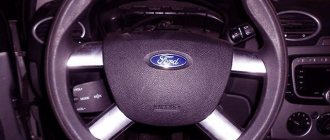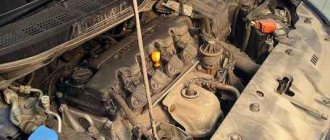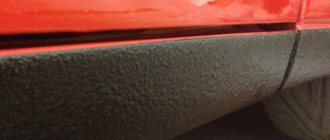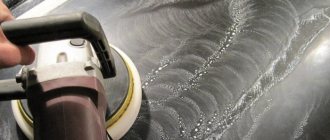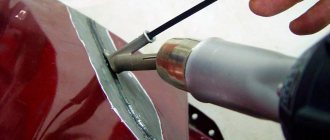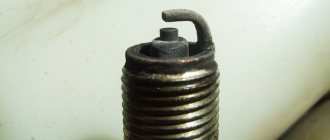How to tell if the carburetor is dirty:
- The engine runs poorly, the speed is unstable;
- Dark smoke comes out of the exhaust pipe with noise;
- Dirty spark plugs - covered with a black coating;
- Fuel consumption has increased.
Causes:
The main reason is diluted fuel. Due to impurities in the fuel, carbon deposits and an oil film, paint and varnish are formed, which cannot be washed off with plain water and household dishwashing detergents. Overuse or poor quality oil will also cause the fuel system to become clogged with dirt and carbon deposits over time. If there is an excess of oil in the intake manifold, it clogs the sensors and throttle valve.
How to clean:
You cannot clean with gasoline, kerosene and diesel fuel, as is recommended in everyday life! The deposits that clog the fuel system are formed from gasoline. It is necessary to use only specialized products for the carburetor and throttle valve - “carbs”, and not universal cleaners, which may contain oils and silicones - this will only contaminate the parts more. The most convenient products to use are aerosols. When cleaning, thanks to the pressure in the cylinder, they wash away dirt and carbon deposits. You can clean the parts without removing them. There are also means for self-cleaning the carburetor system - additive liquids in cans or canisters. They are poured into the fuel tank and then into the carburetor, where they remove deposits and dirt. Such “express cleaning” will not completely remove contaminants and is considered an urgent measure in everyday life. At the same time, cleaning with an aerosol product will take 10 minutes more, but you will see the result immediately.
How to clean:
For manual cleaning with aerosol
– Remove the air filter and spray the product, for example,
Carb Cleaner
Aim-One into the carburetor, choke and float bowl. The dirt begins to dissolve within a few minutes. If the parts remain dirty, repeat the procedure a maximum of 2 times. We start the engine and warm it up at idle for 5-7 minutes. Already with the engine running, we apply the product to the cavities of the carburetor, dampers and other parts of the fuel system. We turn off the engine and continue to spray the cleaner after it stops for 5-10 seconds. Then adjust the idle speed. We don’t do anything else - we don’t wipe it, we don’t rinse it with water. Return the air filter to its place.
Self-cleaning with liquid
– pour the product into the fuel tank. We refuel. The cleaner mixes with the fuel and enters the carburetor when the engine is running. When the fuel burns, the product begins to act and partially cleans the parts.
Manual cleaning with removal and disassembly of the carburetor
– We remove the carburetor and disassemble it. We fold the rubber parts separately - the cleaner should not get on them. Spray the cleaner in an aerosol on the metal parts. If the carburetor has not been cleaned for a long time and its parts are covered with a thick coating, put it in a container and fill it with liquid cleaner, leave it for about night. Then we take it out and carefully clean it with a brush. We blow out the cavities using a compressed air cylinder and, at the same time, dry them. When assembling the carburetor, keep the instructions or assembly manual handy. Adjust the idle speed, starter, and if necessary, adjust the carburetor float mechanism.
How to clean the carburetor without removing the engine?
Many manufacturers use this method because they are not able to carry out partial disassembly of the carburetor.
For such washing without dismantling, a special device for cleaning the carburetor structure (NOT AEROSOL) is installed and one cans for one washing procedure are completely filled.
Algorithm for action in cases of similar problems:
- We know a reliable gas station to sell acidic gasoline;
- remove the plug from the fuel tank;
- carefully open the jar in which the produce is sold;
- The liquid is poured into the tank using a special watering can;
- Next, we fill the tank in the car until it’s full with gasoline (burning).
After this you need to drive until the fire stops. The procedure for accepting someone is complete. This makes it easier to start the engine at the start, and also reduces the toxicity of exhaust gases. In addition, I think that by cleaning the carburetor, doing this can save fuel as much as 7%, which can be of great importance. Researchers of such treatments recommend performing this procedure after skin lesions of 3000 km. However, if you compare with other methods of cleaning the carburetor, it is not very effective, and it may be considered a quick fix.
Indications for cleaning
The fuel used to run cars is often not of high quality. It contains water, dirt, and products that can lead to corrosion. They are the cause of pollution.
You need to flush the carburetor in several cases:
- If lowering the power unit becomes difficult.
- If you press the gas pedal, there is a failure.
- Engine operation at idle is disrupted.
- Too much fuel is being consumed.
It is worth noting that all this may indicate other problems with the car, for example, malfunctions in the ignition system. But in any case, cleaning the carburetor will be appropriate. This is especially true in cases where it has not been carried out for more than a year.
To properly flush the carburetor, you need to remember one feature. This device consists of several smaller parts. For some, washing will be enough. Others will also have to be cleaned.
With the smallest elements other difficulties may arise. Take, for example, jets with channels measuring 2 mm. Cleaning them will be problematic. In this case, blowing with compressed air will be required. But before this, it is better to soak the parts in some solvent. The same applies to large elements.
How can you flush a car carburetor at home and without special tools?
If it is possible to use special equipment for flushing a car carburetor every day, then you can do without them. To do this, you need to soak the parts overnight in gasoline or acetone (the extinguishing agent will go away) and then you can start cleaning the structural elements and blowing them off. The effect in this case will be like this. It is not recommended to pour acetone directly into the tank, as this will lead to wear of the seals and gaskets, as well as the valves formed by the rubber. It is difficult for a carburetor to flush a carburetor at home, and it is necessary to work regularly to ensure stable and reliable operation of the car.
Carburetor structure
The structure of the carburetor is designed approximately in such a way that there are many lines in which air and gasoline flow. For a specific engine operation, a separate system is provided in the carburetor, in which a certain mixture composition is present. The channels have a very small diameter, so small debris can get stuck in them. If this happens, the operation of the carburetor is disrupted. In this case, you will have to disassemble the carburetor and blow it with compressed air to clean all the dirty channels.
Carburetor structure
Signs that the carburetor is clogged:
1. Non-periodic engine speed. The engine runs poorly. 2. Dark smoke comes out of the exhaust pipe. 3. Spark plugs are covered with a dark coating. 4. Fuel consumption has increased.
Cleaning methods
Two media pass through the mixer - air and fuel, and only in one direction, therefore, in principle, there are two types of carburetor cleaning:
- preventative - additives are mixed into the fuel, gradually, in small quantities, removing carbon deposits, oil, films and other foreign substances into the combustion chambers of the cylinders;
- repair - the unit is partially disassembled (the carburetor cover is removed) or dismantled entirely, the surfaces of accessible or all parts are treated with an aerosol or washed in a liquid solution of a cleaning agent, then dried with compressed air, and assembled into their original state for further operation.
In the first option, the carburetor is cleaned, but the load increases on all engine components into which substances washed out by additives in gasoline penetrate. On the other hand, the detergent composition also cleans all other internal combustion engine systems, providing a complex effect.
In the second case, the following options are possible:
- partial disassembly - only the accessible surfaces of the mechanism elements are treated with the cleaner, the rest remain in the same condition;
- dismantling - after disassembling, all parts can be dipped in detergent, wait the necessary time to destroy carbon deposits and films, then blow them with a compressor;
- ultrasonic cleaning is considered the best option, since in addition to dissolving foreign substances with a detergent, cleaning occurs using the cavitation method.
You can choose which method is best to use after comparing their effectiveness and carburetor maintenance budget.
Aggressive
This option is only suitable for cleaning jets without removing or disassembling the carburetor. To do this, swap the high-voltage wires of the spark plugs of cylinders 1 and 4.
Due to ignition desynchronization, a pressure difference is created inside the combustion chambers. Air flows through the nozzle in the opposite direction, the dirt inside it flies out into the float chamber, so the carburetor cover will still have to be removed to clean out debris from the float chamber with a blower. The emergency cleaning of the jets is carried out without cleaning agents.
Upon completion of work, high-voltage wires should be returned to their place.
Soft
Cleaning the carburetor on your own in a gentle way is done by adding additives to gasoline when refueling. The advantages of the method are:
- All internal combustion engine systems are cleaned from the gas tank to the combustion chambers;
- there are drugs that act on all existing contaminants inside the system, or only on varnishes and ointments;
- the technology is suitable for cars with any mileage and wear of parts;
- no need to disassemble components and assemblies.
The main disadvantage is the increase in operating costs for the vehicle owner. This type of cleaning is long-term, additives will have to be purchased and added constantly, and contaminants are removed into the combustion chambers and burned inside them little by little.
Traditional
The classic method of cleaning a carburetor is to disassemble it to treat individual parts with special compounds:
- partial - only the top cover is removed, the carburetor is not dismantled, the detergent is applied from an aerosol can, then the surface is washed with the same substance;
- complete - the entire assembly is removed, disassembled into parts, washed in a liquid solution with your own hands.
Since the lint from the rags, invisible to the eye, remains on the surface of the carburetor, the surfaces after washing are not wiped, but dried with air, blowing from a compressor hose.
Ultrasonic
The most modern technique is cleaning metal parts in ultrasonic baths. The effect of peeling off foreign substances from surfaces is achieved as follows:
- a working medium is poured into the bath - an alkaline, acidic solution or detergent with the addition of these components;
- an ultrasonic generator evenly mixes the liquid, promoting the release of a huge number of bubbles;
- after the balloons attract dirt, they burst under great pressure;
- multiple micro-explosions clean the metal surface due to cavitation.
To dive into the bath, simply remove and partially disassemble the carburetor without removing the throttle valve. Only rubber seals and copper parts, which are washed separately in soapy water, can be dismantled.
The ideal option is to contact a service center that provides such services. In industrial ultrasonic baths, there are resonance adjustments depending on the configuration, weight, size and material of parts, and solution temperature, so such equipment is very expensive and not economically feasible for a private user.
However, ultrasonic carburetor cleaning can be done at home using the following technology:
After which, the grinder is plugged in and runs for 15 - 20 minutes.
Signs of a blockage
The carburetor is cleaned once a year, and also when the following signs of clogging appear:
- delays occur when the gas pedal is pressed sharply;
- difficulty starting the engine is observed;
- extraneous sounds are heard when the internal combustion engine is running at idle speed;
- Fuel consumption has increased noticeably.
Carburetor flushing fluid will also be needed by those drivers who fill their car with low-quality gasoline containing a large amount of corrosion products and other foreign elements.
Detergents
Carburetor cleaning products usually contain alkalis that remove dust, dirt, motor oil, grease and carbon deposits from the surface. Acids that deal with scale, oxides and tarnish are useless in this case; they are more often used in detergents for internal combustion engine cooling systems.
Fuel additives
There are currently four types of fuel additives commercially available:
- octane correctors – fuel stabilizers;
- unit cleaners – used for connecting rods and piston groups and internal combustion engine valves;
- universal – suitable for injection and carburetor engines;
- differentiated - only for the carburetor or exclusively for the injector.
Accordingly, in this case it is necessary to select a carburetor cleaning fluid from the last two groups. Most of these additives contain detergent, demulsifier and corrosion inhibitor in varying proportions. In turn, cleaners also have a classification:
- concentrates are active against any hydrocarbons, therefore they clean all elements of the fuel system, starting with the tank;
- soft agents - destroy only ointments and varnishes, do not affect solid sediments.
For engines with high mileage, concentrates are not recommended, since the tank and pipelines containing solid deposits are first cleaned. The jets and filter curtains may become clogged and the needle may be damaged.
Mild additives are designed for long-term cleaning and prevention, so they are used constantly, increasing the consumption of the operating budget with each refueling.
The Liqui Moly manufacturer's line includes a good additive cleaner, MTX Vergaser Reiniger.
The Hi Gear company produces soft type carb cleaner Proffy Compact:
- exhaust toxicity is reduced;
- restores economizer adjustments and idle speed;
- reduces gasoline consumption by 5%;
- facilitates cold starting;
- improves engine response;
- The packaging is enough for 1 – 1.5 tanks, you need to drive until the backup lamp comes on.
The manufacturer recommends flushing the fuel system after every 3,000 km. Concentrated Kerry product costs 80 rubles, cleans tar and carbon deposits, protects against moisture, corrosion, and is gentle on catalytic converters.
Aerosols and sprays
According to the results of the test, out of five carb clinkers the price category is more than 400 rubles. The leader in packaging is Hi gear and Ravenol carburetor cleaner. Other manufacturers Abro, Liqui Moly and BG have much more modest results.
In the following experiment, a budget aerosol was used, costing within 350 rubles per package from manufacturers:
- AIM-One is a confident 2nd place after Hi Gear cleaning fluid;
- VeryLube – third position in the rating;
- Runway carburetor cleaner - shares the third stage with the previous product;
- Triton – indicators are much worse;
- Ombra – the spray partially coped with the task;
- Laurel - even the Abro carburetor cleaner is superior in cleaning properties to this product.
The universal product GZox is suitable for carburetor, throttle and injector. GZox foam shows the best result in comparison with Hi gear spray, which was the leader in the rating of the previous test, which is quite natural:
- GZox carburetor spray cleaner is positioned by the manufacturer as a decarbonizer for pistons and valves;
- copes with a thick layer of carbon deposits, oil and other dirt on the surfaces of parts operating at high temperatures.
However, “traditional craftsmen” claim that the usual Cillit Bang for the kitchen is similar to the effect of Gzox, while it costs much less and is sold in regular stores.
3M aerosol contains lubricant and organic compounds and is a universal product for carburetor and injection engines.
Mannol sprays work in a similar way, which can also be used to clean the mechanisms under the hood from the outside.
Liquid for ultrasonic bath
Ultrasonic “washing” allows you to do without mechanical mixing, but the result directly depends on the quality of the detergent. Dirt is removed from hard-to-reach places, and micro-explosions of air bubbles eliminate mechanical friction. After cleaning, the carburetor practically restores all metal surfaces, taking into account their actual physical wear.
Sprays are not suitable for ultrasonic baths, since many cans are required to fill the container, so liquid cleaners or concentrated products are usually used, which are diluted in the ratio specified by the manufacturer on the packaging.
Less commonly used is perchlorethylene, diluted with warm water, which washes away resins and oils, does not form toxic substances and is not flammable, unlike solvents. In industry, aluminum alloys are washed in ultrasonic baths with a mixture of trisodium phosphate, soda ash and liquid glass in a ratio of 6/4/10 g/liter, respectively, at a temperature of 40 - 60 degrees for 60 - 120 seconds.
At service stations, they usually use professional fluid Detalan A-10 (6 flushes maximum) or Vigon EFM (up to 10 flushes).
The main enemy of the carburetor is dirty fuel. Due to low-quality fuel, malfunctions in its operation are possible. We'll tell you how to clean a car's carburetor.
Many car enthusiasts believe that the appearance of the carburetor is important for its normal operation and therefore constantly clean it. It should be noted that a carburetor that is not too dirty works no worse than an ideally clean one, because all moving parts are self-cleaning, and dirt cannot get inside the unit. At the same time, each cleaning is an opportunity to introduce contaminants (dust, sand) into the rubbing pairs.
Spark plugs can indicate failures in the concentration of the mixture. The gray-brown color of the candles indicates the correct proportion of the mixture. Black, sooty spark plugs indicate that the mixture is dominated by fuel, while white or light gray spark plugs indicate an excess of air in the mixture.
Carburetor cleaning materials
- Instructions. It is needed to remove, disassemble, reassemble and reinstall the carburetor.
- Clean, smooth rags (not terry).
- Carburetor cleaner (preferably in a spray can).
- A can of compressed air.
- Sticks or toothpicks.
- Wrenches and screwdrivers.
There is a large selection of carburetor cleaners. Go to an auto store and select a cleaner specifically for carburetors.
If they offer another, non-specialized cleaner, refuse it; it may not cope with the dirt in the carburetor. And remember, under no circumstances use WD-40 to clean the carburetor, because... it contains oil. Use a special carburetor cleaner in an aerosol can.
Carburetor Cleaner
Guaranteed and quickly cleans of carbon deposits: throttle valves, air and fuel jets, idle system, carburetor channels.
Without disassembly, it restores the original characteristics of the carburetor. Allows you to adjust the carburetor to minimize gasoline consumption. It is recommended to use every year. When using average quality gasoline, use every 5,000 - 7,000 km. If you thought that it was enough to spray the spray into the carburetor and everything was ready, then we hasten to disappoint you - it will not help. A heavily contaminated carburetor will have to be removed, disassembled and all its components cleaned. To remove and disassemble the carburetor, follow the repair instructions for your vehicle. Be careful not to lose springs, screws and other small parts.
When disassembling the carburetor, clean every part. All rubber and plastic parts should be insulated from the cleaner, as it can deform them.
After you have disassembled the carburetor, collect the metal parts in a metal box or glass jar and fill them with cleaner and let them stand, stirring occasionally. Then, under running water, clean the parts with an old toothbrush or toothpicks.
Do not try to pick at the carburetor outlets or valves. These holes supply fuel and air and are very important for the smooth operation of the engine. Such holes can be cleaned with an aerosol or compressed air. The liquid cleaner can be reused. Some thrifty car enthusiasts use the cleaner several times.
After finishing cleaning the carburetor, dry it thoroughly and reassemble
according to instructions. The cleaned carburetor will need to be installed in the car and re-tuned.
About types of cleaners
Carburetor flushing agent can be sold in the form of a spray or technical liquid. The method of application depends on the state of aggregation of the cleaner.
- sprays. Sold in small cans. Sprays are easy to apply. Along with the cans, nozzle tubes are supplied to make it easier for the cleaning agent to get into hard-to-reach places.
- liquids. Supplied in plastic containers of various sizes. No carburetor disassembly required. Filled into the fuel tank. They are less effective compared to sprays. However, they save the car owner’s time.
Washing methods and products used for it
There are three ways to flush the carburetor yourself:
- without removing the engine or disassembling it;
- by partial disassembly;
- by complete disassembly.
The first option involves adding chemically active liquids (additives) to the fuel. In other words, you need to pour a certain amount of cleaning agent into the tank and continue driving your car quietly, without wasting your time. Gasoline with an additive, moving through the fuel system, will itself dissolve and remove dirt. Of course, this method cannot be called effective, and everything that we tried to get rid of will inevitably end up in the engine cylinders.
To flush the carburetor without dismantling it, special additives are used
Flushing the carburetor by partial disassembly is the most popular type of maintenance. We will have to remove the air filter, cover, remove all elements that may be dirty, wash them and put the device back together. The efficiency of this method is quite high, and we can visually determine how clean the unit has become.
To flush, you will need to remove the air filter and carburetor cover.
Well, if you remove and disassemble the device completely, soak all its parts in cleaning liquid, and then rinse them manually and blow them with a stream of air, we will get a practically new carburetor.
Not so long ago, car owners cleaned the carburetors of their cars using liquids that can usually be found at home:
- refined gasoline;
- kerosene;
- diesel fuel;
- solvent.
Yes, they do a good job of removing various types of dirt and deposits on the internal walls of the device, especially if you have the opportunity and time to soak the necessary parts in them for a while. But today there is no need to use such means. It is better to purchase a special liquid from a car store. There are products on sale for both self-cleaning of the fuel system (filling the tank) and for servicing carburetors. The most popular and effective of them are:
- Hi-Gear is a line of products for flushing the fuel system and carburetor. It has high dissolving abilities. Does not harm system elements. Available both in the form of additives and in the form of an aerosol;
Additive "Hi-Gear" for filling into a car tank
Some tips for choosing a cleaner
Each company that produces special auto chemicals for cleaning carburetors strives to make their products of the highest quality possible and to give them certain special characteristics. This, on the one hand, allows motorists to choose the best (in their opinion) cleaner, but, on the other hand, makes this very choice difficult. Adding to the complexity is the fact that experts do not give any special recommendations on the selection of a cleansing composition.
They advise paying attention to the fame of a particular manufacturer and the presence of favorable reviews about its products. A test of a specific cleaner, performed by professionals and posted on a specialized web resource or in a magazine for vehicle owners, can also be a good help for drivers. Very often, it is the test of several compositions under different brands that allows a person to decide which mixture he should buy.
In addition, professionals recommend choosing cleaners that do not have an overly aggressive effect on the following components of the fuel system:
- catalytic converters;
- oxygen flow sensors and other monitoring devices;
- turbochargers.
We will not give you advice on the selection of cleaning mixtures, but will simply describe those compositions that are most often purchased by domestic car owners.
Which carburetor cleaner is better to choose?
Comparison of carburetor cleaners
However, the most important question that interests motorists in this regard is which carburetor cleaner to buy? It’s worth noting right away that there is not and cannot be a definite answer to this. Currently, there is a wide variety of different products on the market. Therefore, the purchase decision must be made based on information from the manufacturer, as well as reviews from real buyers of a particular purifier. After all, you can come to the truth only by trying many different liquids for carburetor parts of different degrees of contamination.
Here is a list of the most common carb cleaning products. They are sorted in random order, since, firstly, their assortment differs in different parts of our country, and secondly, sometimes there are very contradictory reviews about this or that carburetor cleaning product from car owners.
| Product name | Description | Sales form and volume | Catalog number | Price for autumn 2021, rub |
| Liqui Moly Vergaser-Aussen-Reiniger | Quite a popular and high-quality liquid. Using this composition, you can remove not only carbon deposits and tar deposits from the surface, but also clean channels and throttle valves. The product can also be used to clean injectors | Aerosol in a 400 ml can | 3918 | 280 |
| ABRO CARB&CHOKE Cleaner | Designed for quick and high-quality cleaning of carbon deposits, carbon deposits and dirt from carburetor systems and parts - idle system, carburetor channels, throttle valves, air and fuel jets, intake valves and piston heads | Aerosol in a 283 ml can | CC200 | 172 |
| RAVENOL Carb Reiniger Spray | Guaranteed and quickly cleans of carbon deposits, carbon deposits, resins and varnish films: throttle valves, air and fuel jets, idle air system and valve, carburetor channels, intake valves and piston heads | Aerosol in a 400 ml can | 4014835703544 | 450 |
| 3M PN08796 | This is a highly effective aerosol cleaner for removing tar, oil and carbon deposits from automatic choke valves and carburetors. | Aerosol in a 354 ml can | PN08796 | 339 |
| HI GEAR HG3201 | The aerosol composition effectively and without disassembling restores the characteristics of the carburetor, allowing you to avoid costly and time-consuming repairs to the power system | Aerosol in a 312 ml can | HG3201 | 320 |
| XADO JET100 ULTRA | Universal carburetor and injector cleaner | Aerosol in a 250 ml can | XB30014 | 460 |
| MANNOL 9970 Carburetor Cleaner | Capable of providing high-quality cleaning of the carburetor without disassembling it. Removes high temperature deposits from both the internal and external surfaces of the carburetor. Completely optimizes the operation of the fuel system. This product is suitable for two- and four-stroke gasoline engines, with or without catalyst. | Aerosol in a 400 ml can | 2430 | 120 |
Remember that the use of “carb cleaner” is only a preventive measure aimed at extending the life of the fuel system and the engine as a whole. However, not a single, even the most effective, product can replace a complete cleaning of the fuel system with its flushing and adjustment .
Do-it-yourself carburetor cleaning
Most new gasoline cars are equipped with fuel injection systems. However, on our roads there are a sufficient number of cars with carburetor engines. They often have weaker performance characteristics, but remain popular due to their high self-repairability.
Most systems in carburetor cars can be put in order in a garage with a minimum set of auxiliary tools. The list of available operations also includes carburetor cleaning.
- 1 Why do this
- 2 Preparatory activities
- 3 Cleaning
- 4 Conclusion
Washing with partial disassembly
Let's consider the process of flushing a carburetor with its partial disassembly using the example of a Solex carburetor and Jet 100 Ultra. You don't need to buy a lot of it. One 200 ml can will be enough. The cost of this product is 450–500 rubles. In addition to the special liquid, you will also need:
- set of wrenches;
- Phillips and slotted screwdrivers;
- pliers;
- a container with a wide “neck” with a volume of 2–3 liters (for soaking the carburetor lid);
- a container with a wide “neck” with a volume of 0.2–0.5 l (for soaking small parts);
- kerosene (refined gasoline, acetone);
- tire pump or compressor with a tapering tip;
- toothpicks;
- old toothbrush;
- a clean, dry, lint-free cloth (preferably rough);
- a small wooden spatula (like an ice cream stick).
Washing procedure:
- Open the hood.
Remove the air filter cover by unscrewing the nut with a 10mm wrench and opening the 4 spring latches. To remove the cover you need to unscrew the nut and press the latches - We take out the filter element.
Using a size 8 wrench, unscrew the 4 nuts on the studs securing the filter housing. Do not drop the nuts inside the carburetor! Remove the filter along with the rubber seal. Removing the air filter housing - Using a Phillips screwdriver, loosen the clamps of the fuel and ventilation hoses. Disconnect the hoses.
- Disconnect the wire tip from the solenoid valve terminal.
The power wire is connected to the solenoid valve - Using a Phillips screwdriver, unscrew the screws securing the cover to the carburetor body.
There are only 5 of them. To remove the cover, you need to unscrew five screws - Carefully remove the cover from the body, being careful not to damage the gasket.
The cover must be carefully removed so as not to damage the gasket. - Using a 13 key, unscrew the solenoid valve.
Disconnect the idle jet from it. The valve is unscrewed with a 13 key - Using the same key, we unscrew the carburetor filter plug and the inlet fitting.
Don't lose the O-rings located on both elements! The fuel filter is located under the plug - Using a slotted screwdriver, unscrew the air jets along with the emulsion tubes.
The jets are unscrewed with a slotted screwdriver. Below them are emulsion tubes - Using a thin slotted screwdriver, pry up the upper “proboscis” of the sprayer and remove the sprayer.
To remove the sprayer, you need to pry off its upper “proboscis” - Using a slotted screwdriver, unscrew both fuel nozzles.
Fuel jets are unscrewed with a thin slotted screwdriver - Using pliers, remove the diffusers of both chambers.
Diffusers are removed using pliers - We put all small parts, with the exception of rubber elements, into a small container and fill them with kerosene (gasoline, solvent).
Before cleaning, it is recommended to soak the parts in kerosene or acetone. - Carefully place the carburetor cover, so as not to disturb the adjustment of the float mechanism, in a large container and also fill it with kerosene.
- Let the parts soak for 30–60 minutes.
- Take a bottle of cleaning agent.
We attach a tube to its sprayer (included in the kit). We apply liquid to the internal surfaces of the carburetor body (walls of the float chamber, air and fuel channels, throttle valves, their drive elements). After this, we process the outside of the carburetor. Let the product “work” for half an hour. Apply liquid to the internal surfaces of the carburetor - In the meantime, take a toothbrush and clean the carburetor cover from the inside, and then from the outside.
To remove complex contaminants, use a wooden spatula. If necessary, wipe the lid with a clean cloth. The lid must be removed first from the inside, then from the outside. - We take out the small parts of the carburetor from the kerosene and treat them with cleaning liquid from the inside.
After processing, we blow out all the jets, the plug strainer, the accelerator pump nozzle, the emulsion tubes, and the diffusers with a stream of air. To do this, we use a pump or compressor. If there is visible contamination of the channels, remove them with toothpicks. After washing, the jets must be blown out with a stream of air. - Using a clean rag, carefully wipe the carburetor body. There is no need to wipe the interior surfaces!
- We reassemble the carburetor in the reverse order. We do not install the air filter housing.
- Let's start the engine. We take a bottle of cleaning liquid and spray it into the carburetor, periodically “gassing”. We continue this procedure for 2–3 minutes.
- We turn off the engine and install the air filter.
SOLVENT CLEANING
The process is long, it will take a couple of months, but the result is worth it. Required: four jars of solvent. any grease remover for stoves and ovens. carburetor cleaner. We take the solvent, pour it into a container and soak the carburetor in it for two or three months. Observing periodically. The solvent will slowly evaporate, so it will be necessary to drown the carburetor in sufficient quantities so that after a couple of months it is still covered with solvent. The main deposits will be removed, but a layer of fat will still remain. We remove it using a grease remover for conventional gas stoves (when using a grease remover, read the instructions) Take the carburetor and place it on some surface so that it is easy to wash off the remaining solvent from it (wash off with warm water) Take the grease remover (observe precautions) and spray the product on We wait for the carburetor according to the instructions for ten, fifteen minutes. Next, we take the brush and clean it a little and we can already see the result. Remains of grease stains disappear. If it is not completely cleaned, the procedure can be repeated until the dirt completely disappears. Carburetor cleaner is used for jets and all small parts. After drying, there is not much residue left, but it comes off very quickly, you just need to wipe everything with a dry, clean cloth.
The main signs of contamination of the fuel device
As a rule, car owners do not carry out vehicle maintenance at the frequency indicated in the owner's manual. Therefore, in order to avoid carburetor damage, you need to know the main signs indicating its contamination.
These include:
- increased fuel consumption;
- difficulty starting the engine;
- toxic exhaust gases;
- unstable operation at idle;
- reduction in power.
The above symptoms may also be the result of other problems. Therefore, to accurately determine the cause of their occurrence, it is necessary to diagnose the engine at a service center. If the problem is precisely contamination of the fuel device, then it can be solved with the help of a cleaner.
Which cleaner is best for removing stains?
You can purchase an aerosol or liquid carburetor cleaner at the car market or a specialty store. These funds have different principles of action.
The liquid preparation is poured into the tank, where it is mixed with fuel and, when the fuel is burned, cleans the carburetor elements. You won’t be able to get an ideal result this way, but you can remove a significant layer of dirt for a certain period of time.
In order to use the aerosol product, it is necessary to disassemble the fuel unit. All elements, after processing, are cleaned manually. In this case, it is necessary to use a special nozzle that cleans the damper and walls of the device from soot and dirt without damaging them.
Manual cleaning is more effective than self-cleaning, but requires more effort and time.
Features of the use of aerosol products
Aerosol preparations are the priority choice of most car owners because they have high cleaning efficiency and can be used as often as necessary. Many people use them as a preventative measure to maintain the carburetor in good condition, since fuel consumption, engine starting, and stable operation depend on its operation.
It consists of various aerosol compositions that provide deep penetration of contamination. The chemical compounds that form the basis of the drug contain solvents and inorganic substances.
In order for aerosol products to work, you must wait a few minutes after they are used. The exact time required to clean the stain is indicated on the packaging and depends on its composition.
Composition of an aerosol type cleaner
The quality of cleaning the fuel unit from dust, soot and film largely depends on the composition of the cleaner.
Despite the fact that the product has a fairly large list of positive qualities that allow you to effectively clean the fuel device, it cannot fully replace system maintenance. Systematic cleaning of components during maintenance and repair in a service center, as well as periodic preventive maintenance with a cleaner, will ensure the durability of the carburetor and allow you to use the technical capabilities of the car.
How to choose an effective cleaning product
The automotive chemicals market is saturated with products that meet the requirements of any buyer. This applies not only to quality, but also to cost. Every year, manufacturers try to improve their products by improving various characteristics.
Choosing a cleaning product is becoming increasingly difficult, since there are really many worthy samples.
It is best to buy products that have proven themselves in the market and are in sufficient demand among motorists based on positive reviews. Having studied a sufficient amount of information on the topic, as well as familiarized yourself with the test results, you can make a fairly objective assessment.
Most experts encourage drivers to choose products that will not affect the performance of the oxygen sensor, turbocharger, catalytic converters and other devices that play the role of control devices. According to the rules, the manufacturer must indicate information about possible damage to system elements.
Cleaners with high ratings and positive reviews
1.
Hi-Gear carburetor cleaner is very popular due to the fact that it can effectively remove various carbon deposits and carbon deposits.
The company has developed a special synthetic formula that allows you to quickly and efficiently remove complex contaminants. Among the assortment there are products that have different levels of aggressiveness.
Car owners who have used the drug High Gear note the effectiveness of liquid and aerosol products. After their use, the toxicity of the exhaust is reduced, and the consequences of the constant use of low-quality gasoline are also neutralized.
The price of Hi-Gear cleaning product depends on its type and composition. For example, aerosol 510 gr. costs 525 rubles.
2.
Abro carburetor cleaner is a good tool for cleaning fuel device elements and injector throttle valves. Aerosol 340 gr. will cost 300 rubles.
Conveniently, to service the system you only need to disconnect the air filter and process all parts both inside and outside. To make the effect even greater, you need to spray the product into the carburetor while it is running.
It is important to treat all areas, including the air dampers. The manufacturer suggests using the product for other engine components and mechanisms on which contaminants may form.
Contact of Abro with paint can lead to corrosion of the surface, so if this happens, you must immediately rinse the area with water and wipe with a cloth.
3.
There is a wide selection of Manol carburetor cleaners on the auto chemical market. Most often, motorists with a carburetor engine use the MANNOL Carburetor Cleaner 9970 model.
It usually costs less money, but also provides high cleaning efficiency. It can be used to clean both the inside and the outside. The capacity of the aerosol spray is 400 ml, and the price is 155 rubles.
Car owners note low consumption with fairly high efficiency. Can be used for other engine components.
4.
The 3ton company produces liquid and aerosol cleaning products for fuel equipment. The model range is represented by the TT-300 (RUB 71) and TS-509 (RUB 91) cleaner. They are perfect for removing tar deposits and other waste substances.
Despite the rich assortment of auto chemicals, choosing a carburetor cleaner is quite difficult, which is due to the variety of flushing technologies, the actual engine life and other factors.
Products from famous brands are not always effective enough to remove films on the surfaces of carburetor parts, so this guide provides a rating of popular products - carb cleaners from different companies.


